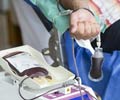Complications & Risks to Donors
Studies reveal that there is a minor chance of risk among donors. However, no death has been reported.
Sometimes blood donations can put a person at risks. Donors are usually screened for the presence of risk factors/diseases. Some of the risks faced by a blood donor are listed below:
- A quick change in BP can result in hypovolemic reactions-fainting might ensue.
- Less than 1% suffer from bruising by the needle.
- Some the donors suffer from bleeding.
- Blood donors may occasionally react adversely to the sodium citrate used to prevent coagulation during apheresis. Sodium citrate, returned to the donor along with blood components that are not required, can bind together the calcium present in the donor’s blood. This may cause hypocalcemia-the symptoms of which include tingling in the lips, convulsion or even graver symptoms. This condition can be prevented by providing calcium supplements to the donor.
- Manual apheresis, without the help of automated machines can lead to transfusion reactions.
- Usage of non-sterilized equipments and needles can increase risk to donors.












